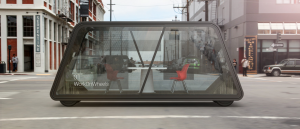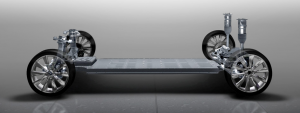Driverless Hotel Rooms: The End of Uber, Airbnb and Human Landlords
公開日:
:
Human LOGISTICS
How driverless vehicles can enable ondemand accommodation for one night or 1000, and at rates 10x cheaper than your rent bill。
“Good evening ladies and gentlemen, we’re about to begin our descent into Sydney. Please fasten your seatbelts and place your trays in the upright position. Local time is 8:42pm and a humid 27 degrees. Our flight crew wishes you a Happy New Year, and we hope you fly with us again in 2025.”
Screeech. You’ve landed. Time to relax those butt cheeks.
It was only this morning you booked this flight, and now you’re on the other side of the planet. Amazing. You’re nervous but excited to visit Australia for the first time. One week to explore the city and five weeks on a new design project. When that project match showed up in your feed you claimed it in two seconds. You’ve already earned 24,000 $design in the peerism economy.
Ping. “Need a room?”.
You hadn’t booked any accommodation yet. “Yes please”, you respond.
“Just out the front, number 420”.
You giggle, then follow the augmented directions leading to a sleek driverless hotel room. It’s about the size of a mini bus but without the seats, steering wheel and engine. A giant transparent panel stretching the length and height of the vehicle greets you on approach. The panel opens and you step inside.
Inside is everything you’d expected. On the left, a couch seat that folds into a queen-sized bed with the push of a button. To the right, a small kitchenette with electric stove, running water, sink, microwave and bar fridge. Behind that is the detachable bathroom module with toilet, shower and wash basin.
“Hi there, welcome home. Hungry?”
“I could go some pad thai and a beer thanks”, you respond.
“That’ll be here in 6 minutes. Want a quick tour of the city?”
“Nah early one tonight. Let’s checkout Bondi beach tomorrow”, you say.
Your room begins driving itself towards Bondi and a live map displays on one of the side panels. You sit back and relax with some Netflix on the other side panel. Exactly 6 minutes later, a drone lands on the roof and lowers your order through a compartment in the ceiling. If you need to order any package you simply ask the room and a drone arrives; it even does laundry!
“Arriving at Bondi Tower 7”.
You look up at a lego-like modular skyscraper reaching high above the moonlit clouds. Your room docks with an electric skate and is elevated thirty stories up before slotting into a window-facing position. One of the side panels opens smoothly to reveal a large adjoining living room module.
Extra modules are optional and can be requested ondemand: an extra bed, private gym, spa, snackbar, office and more. On various levels of the tower are cafes, restaurants, retail stores, entertainment areas, communal kitchens, laundromats, a gym and even a cinema. Luxury living at $30 per night.
You fall asleep as your driverless hotel room recharges itself ready to take you on an extensive tour of the city and beaches tomorrow. Your six week experience will be personalized to your precise ondemand preferences including invites to local communities, events and interest networks.
“Goodnight”.
Crisis of Car Manufacturing
The image above is a screenshot of the thousands of new, unsold cars sitting at a dock in a town named Sheerness in the United Kingdom. This is one of hundreds of locations where new cars sit empty and unused. And while auto manufacturers typically keep a 60 day supply, US manufacturers hit a record high of over 4 million unsold vehicles in their inventory in 2016.
The issue of overproduction is a common crisis in Capitalism where more goods are produced than there are customers to consume them. In a free market this should result in prices dropping until the excess supply lowers to meet demand. But what typically happens is that manufacturers either artificially restrict supply or resort to simply destroying the unsold goods.
Vehicle manufacturing faces a unique challenge with oversupply because the production lines are very expensive to initially setup and very expensive to stop. When a vehicle production line is down it costs $22,000–50,000 per minute in lost revenue and wage costs. So you can bet that if a particular car model isn’t selling, they’ll continue to produce until the next year’s model.
The inevitable reality of ondemand self-driving cars poses a huge looming existential risk to the entire auto industry.
With nearly 1.3 billion vehicles on the planet and more than 94 million new cars rolling off the production lines each year, the auto industry looks rather similar to a runaway AI paperclip maximizer; consuming vast resources to sell thousands of various car models, which we then park idle for 95% of the time.
However if ondemand driverless vehicles come to fruition then your $10 Uber ride suddenly becomes a sub-$1 ride anywhere in the city. At that point the appeal of owning a car will diminish for most of the population, thus creating a massive oversupply of unwanted human-driven vehicles.
Given the forecasts of 2 billion vehicles on the roads by 2040, and considering driverless vehicles need only be idle while recharging, we can roughly calculate that only 100 million ondemand driverless vehicles will be required to replace all 2 billion human-driven vehicles.
In other words, when every auto manufacturer begins producing the high-demand self-driving cars it will take just one year to reach oversupply.
How and to where will auto manufacturers pivot to stay alive?
Modular Driverless Rooms
The key concept to grasp with driverless cars is that they truly redefine all of our assumptions and preconceived notions. Combustion engines are replaced by two small electric motors, the dashboard and steering wheel are unnecessary, and safety features are redundant when the cars don’t crash.
Driverless vehicles are simply rooms sitting atop an all-electric drivetrain and rechargeable battery pack with a few extra visual, laser or radar sensors.
In a Tesla Model S there are only 18 moving parts compared to the 1500 in an average internal combustion engine vehicle. As such it’s predicted that by 2025 all new vehicles produced will be 100% electric and cost much less than the cheapest combustion engine vehicles sold today.
This opens endless possibilities to re-imagine vehicles as moving rooms able to cater to a vast array of human experiences and activities:
the driverless office
the driverless boardroom
the driverless gym
the driverless bedroom
the driverless bathroom
the driverless cafe
the driverless cinema
the driverless shop
These rooms need not be used in isolation either. They can be dynamic, modular and interconnected with other driverless rooms via an ondemand request. Tap a button or speak a request, and moments later you can have a bathroom or gym module drive itself to your location and autonomously connect to the office module you’re currently working from.
When auto manufacturers rapidly meet the 100 million vehicle demand for driverless ondemand transport, they will inevitably pivot operations to manufacture driverless modular rooms that cater to specific human experiences. Any auto manufacturer that fails to pivot will cease to exist.
Edit [5 days later]: Toyota is pivoting to become a driverless room manufacturer with their e-Palette drivetrain, to become a “mobility service company”.

Lego Skyscrapers + Decentralized City
If we assume the technological and economic drivers propel our reality towards driverless modular rooms, then we’ll inevitably require these to stack vertically in skyscrapers within cities. The forces of inertia will always remain, so we wouldn’t expect people to want to be constantly moving.
Ondemand driverless rooms will definitely offer the option of going to sleep in one city and waking up in another, or requesting add-on modules while in transit to a destination. But as more people adopt this way of moving and living in a city, we’d ideally prefer to reduce the number of lanes on roads, reduce the number of parking spaces and reduce the environmental footprint.
The best way to achieve this is to route the driverless rooms through tunnels under the city while in transit, and to stack the rooms vertically when stationary. While in transit the rooms can connect to other modules like train carriages, and while stationary the rooms can connect on all sides.
Immense vertical skyscrapers can autonomously lift these driverless rooms and their passengers hundreds of meters up, where they’re slotted into position before the wall panels open to reveal other connected room modules.
The image to the left is a pod vending machine concept by designer Haseef Rafiei which fantastically conveys the vision, though in a fairly industrial architectural design. Imagine a similar tower with a modern and luxurious design for driverless hotel rooms and apartments. Various levels could include restaurants, nightclubs, retail stores and entertainment.
What’s fascinating about this idea is that driverless hotel rooms are truly no different to driverless apartment rooms.
In today’s reality we think of hotels as expensive accommodation intended for a few overnight stays. Hotels and Airbnb accommodations are able to charge expensive fees due to their fixed and high-demand locations within the city.
By decoupling accommodation and the physical location, we decentralize housing and empower the individual to instantly switch to alternative locations. If Bondi Tower 7 is charging a $50 overnight fee while Bondi Tower 36 is charging a $10 overnight fee, then your room can haggle on your behalf and relocate to the cheapest location that remains within your preferences.
In fact these driverless rooms and “parking” towers can leverage blockchain technology to remove the human landlord altogether. Inexpensive, all-electric driverless rooms can roll off the production lines at today’s rate of one to two cars per minute and immediately begin housing and transporting humans.
The driverless rooms could own themselves, manage their finances and schedule their own maintenance autonomously via smart contracts. Once they’ve paid-off their construction costs, they can offer their services at rental fees just enough to cover their low operating costs, but at zero profit.
And if we scale this vision of the future out further, why not build entire cities from driverless modular rooms? Beginning with a flat and solid surface we could instruct these rooms to behave as building blocks which self-assemble into skyscrapers, parks, bridges and everything you expect to see in a city.
Decentralized modular cities could adapt to optimize for perfect living conditions that maximize the happiness and creativity of all inhabitants.
If you enjoyed this, you’ll love my post on driverless van homes!
関連記事
-

-
Analysis and Future Considerations on Increasing Chinese Travelers and International Travel & Human Logistics Market (1)➀
Ⅰ It is national income, not the number of foreign
-

-
Analysis and Future Considerations on Increasing Chinese Travelers and International Travel & Human Logistics Market ⑨
VIII Caribbean cruise and the United States 1 Ove
-

-
二月五日チームネクスト総会講演「総合生活移動産業の今後の展望」(45分)趣旨 人流・観光研究所長 寺前秀一
二月五日チームネクスト総会講演「総合生活移動産業の今後の展望」(45分)趣旨 人流・観光研究所長
-

-
ニューヨーク市長がUberの台数制限案を引っ込めたという記事 July 22, 2015 De Blasio Drops Plan for Uber Cap
De Blasio Drops Plan for Uber Cap After long, bitt
-

-
Analysis and Future Considerations on Increasing Chinese Travelers and International Travel & Human Logistics Market (1)④
Ⅲ Human Logistics situation in the ASEAN-Pacific r
-

-
TTRA発表2015年12月5日 Future Direction of Tourism Policy Studies in Japan
Future Direction of Tourism Policy Studies in Japa
-

-
Analysis and Future Considerations on Increasing Chinese Travelers and International Travel & Human Logistics Market ⓫
X The direction Japan should take in the global tr
-

-
The basic viewpoint of discussing Human Logistics and Tourism
In the process of studying Tourism Studies, consid
-

-
Analysis and Future Considerations on Increasing Chinese Travelers and International Travel & Human Logistics Market (1)③
3 Mainland China and the fate community of Hong Ko
-

-
Encounter of the concept “Travel for pleasure” and the Japanese word “KANKO(観光)”
Encounter of the concept "Travel for pleasure" and



